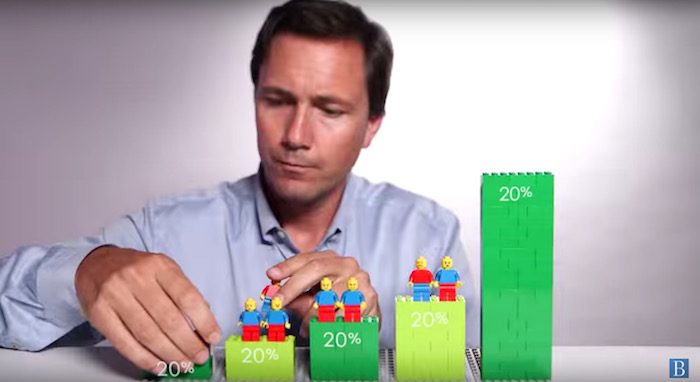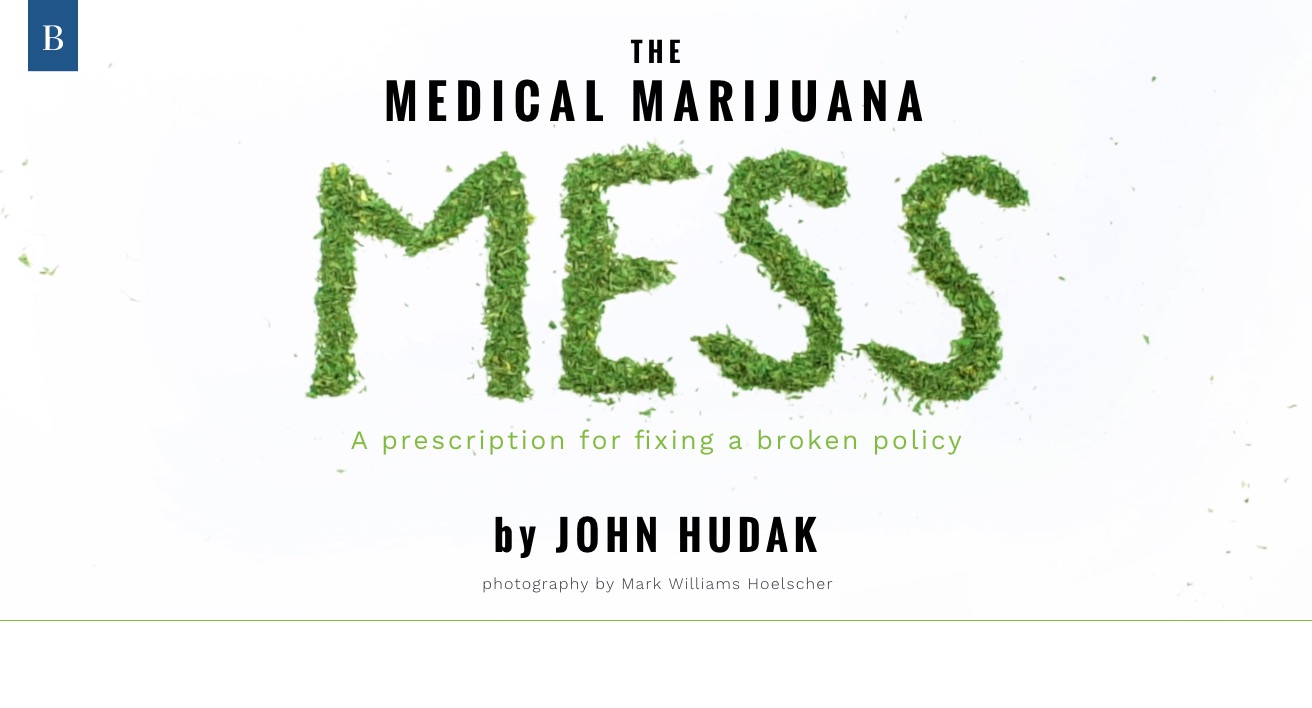
When scholars and experts study social mobility, they typically use intergenerational quintile transition matrices to discuss inequality and economic opportunity.
In August 2014, Richard V. Reeves, a senior fellow at the Brookings Institution, took a slightly different approach to highlight the concept: In a YouTube video, Reeves used Lego to illustrate how low-income Americans are struggling to climb the economic ladder. The video was the brainstorm of George Burroughs, Brookings’ creative director, but Reeves didn’t come around immediately.
“I’m a Brookings scholar working on these issues,” Reeves said. “We’re a serious institution that does serious work and that both needs and wants to be taken seriously: Do I want to play with Lego?”
“I’ll be honest with you, I had a moment,” he continued. “I’m a big believer in communicating our messages clearly and simply, but I had to take a deep breath, to be honest, and had to trust George and the process and the team, and trust their instincts around it.”
Since it debuted nearly two years ago, the video has amassed nearly 350,000 views on YouTube. It’s far and away Brookings’ most successful video. (An hour-long interview with Bernie Sanders is next, at about 130,000 views.)
Reeves’ video is illustrative of how the 100-year-old Washington think tank, which has long been described as a university without students, is operating more like a digital news organization these days. Last year, Brookings launched Brookings Creative Lab, a group helmed by Burroughs, that focuses on these more interactive reporting methods.
Brookings publishes up to 20 pieces of content each day — from interactive narrative stories and quick newsy posts to videos and podcasts. It has launched more than 10 different blogs. Its website averages about 1.5 million unique visitors per month.
Because Brookings is a nonprofit with more than $480 million in assets, it’s not dependent on traffic for revenue. Instead, it says it measure its success through influence and impact, and that’s why it wants to make its work available more widely.
“I wanted to make our content more accessible in both form and delivery. That meant unpacking the 40-page PDF that was the general bread and butter of brookings.edu,” said David Nassar, Brookings’ VP for communications, who joined the think tank in 2012 and has led the overhaul of its digital strategy.
As newsrooms continue to scale back — The New York Times is reportedly planning more than 200 layoffs in early 2017 — think tanks, NGOs, and other advocacy groups have begun doing their own reporting. The conservative Heritage Foundation hired its first foreign correspondent last year, for example, and much of the early reporting on contaminated water in Flint was done by an investigative journalist working for the ACLU.But instead of hiring of traditional reporters, Brookings turns to its more than 300 experts across nearly 50 programs, centers and projects to find new ways to reach an audience beyond the corridors of power in Washington.
“The internet is allowing people to create their own credibility,” Nassar said. “Go back 20 years ago: For something a Brookings scholar wrote to be perceived as impactful and present, it would have to be published in The New York Times or The Washington Post. Now we have the capacity to publish this content ourselves. Obviously, The New York Times is still important, but we have the capacity to deliver our own message as well.”
Brookings has faced some skepticism from some of its experts who don’t want to change their workflows or try new things. (That might sound familiar to anyone who’s tried to enact change in a newsroom.)
Still, Brookings has been able to convince experts like Reeves to work with communications staff to write blog posts, produce videos, take part in Facebook Live segments, and more.
Burroughs, the creative director, said the video with Reeves was a “turning point” for Brookings as the scholars began to understand that they could present their ideas in internet-friendly ways without dumbing them down.
“They found we’re treating it with the respect it deserves, but that a visual aid such as a toy could generate a lot of interest and still maintain the integrity of the evidence and the scholarship,” Burroughs said. “That video was a big turning point for us. There’s a little bit of a trust factor, like a first date. [They’re] willing to hear these ideas and try something new, but when I first pitched it there were a lot of skeptics.”
That’s also involved getting out of Washington and doing reporting. Last year, Brookings produced a video in the wake of the protests in Baltimore that occurred after the death of Freddie Grey. The video featured Brookings fellow Jennifer S. Vey, but in addition to presenting data about poverty and the city’s population, staffers actually went to Baltimore and interviewed high school students to try and understand what it’s like for them to grow up in distressed neighborhoods.
“That, to us, was old-school journalism. We could’ve just done a video and said, ‘Hey look,’ and ticked off these numbers, but I don’t know that it would’ve had the same effect, Burroughs said.
Brookings senior communications advisor Tracy Viselli works closely on a day-to-day basis with many of the think tank’s scholars. She pitches digital storytelling methods as paths to a bigger impact and wider readership.
The definition of “impact” differs from discipline to discipline, and Brookings’ communication staff tries to be cognizant of that. For instance, some experts in niche fields may only want to be published in a specific journal, while others may be more interested in appealing to a broad audience. Regardless, Viselli said her goal is to publish at least one blog post for every research paper or journal article that a Brookings expert produces.
“There’s the full-sized and there’s the bite-sized policy,” she said. “There are audiences for bite-sized policy.”
Fred Dews, managing editor of new digital products, said the staff tries not to overwhelm the experts with demands for their time. Instead, it attempts to balance its requests and figure out which will be most impactful. “The challenge we have is to coordinate all these different requests,” he said.
It’s taken awhile for Brookings to get to this point digitally, though. It launched its first website in 1995 , and Dews joined the think tank 15 months later. He edited Brookings’ website for 14 years before taking on his current role.
In those early years, if someone wanted to add a new post to the website, they had to submit a ticket to Brookings’ IT staff. Though that policy was changed pretty quickly, the IT team was involved in managing the website in lesser capacities until it was redesigned in 2007.
Even then, Brookings’ central communication team was responsible for publishing day-to-day content directly to the site. Nassar pushed that responsibility to Brookings’ individual programs, and now the central staff is more focused on more strategic efforts to enhance its work and grow the audience.
Brookings now has two full-time developers on the communications staff, and Nassar has increased the size of the video team from two people to five. There are also staffers focused on social media and email newsletters.
Brookings has long had accounts on Facebook, Twitter and other social platforms. In recent years, it’s also begun experimenting with other formats and different ways of telling stories on its own site.
One of those content distribution methodologies is the Brookings Essay, a longform feature. The think tank has published 16 essays on topics such as medical marijuana and ISIS leader Abu Bakr al-Baghdadi. The stories are accompanied by interactive data visualizations, videos, and other side bars.

“The heart of the Brookings Essay is the text, the author’s story,” Dews said. “The text is the main thing, but we are trying to present it in a way that is captivating, visually engaging, and might have a few extras that you don’t see in the text.”
Like practically every other digital outlet, Brookings has also been experimenting with Facebook Live and plans to publish Facebook Instant Articles as well.
In addition, the think tank has outposts in Qatar, India, and China. Over the past several months Brookings has begun translating some of its posts into Arabic. It’s also tried reaching English-speaking African audiences, and plans to expand those efforts to Francophone Africa with posts in French.
Brookings will launch a redesigned website this fall, and as new platforms continue to emerge, it’s likely the institution will be there as well, as it tries to expand its mission of impact and compete with other outlets — whether they be think tanks or news organizations — for an audience.
“We have to come up with new ideas constantly to get the same audience that a lot of these huge publishers have,” Burroughs said. “We have to do something different. We can’t do the same thing they’re doing.”